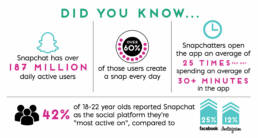As an education technology company trying to sell digital learning tools to college students, one could argue that Snapchat is the most important social media platform to be marketing on. With that being said, Snapchat is also the least understood among major social sites like Facebook, Instagram, YouTube, and Twitter.
Marketing to college students effectively requires businesses to create content that meets their audience where they’re focusing their eyeballs – and right now, the attention is on Snapchat. Whether you’re an educational technology company selling digital textbooks, online simulation software, exam prep resources, or online courses, try adding the following Snapchat strategies to your marketing mix and take more potential buyers from consideration to sale.
If you’re new to the world of Snapchat, this is an excellent “how-to” breakdown of everything you need to know to comfortably use the platform. This blog post is geared more towards tactics and strategies for selling to students and increasing awareness of your edtech product, but it’ll be easier to follow if you have an understanding of how Snapchat works.
In a super small nutshell, Snapchat allows you to take quick pictures or videos, add text and fun overlays, and share them with your friends. You have a couple options for sharing Snaps… You can send them as personal messages to specific friends, which lets them view your message ONCE. Or, you can publish them to your ‘Snapchat Story’, which keeps your content visible to all of your followers for 24 hours after you post it.
Put yourself in the shoes of a college student for a minute. Snapchat is the place you post and share things you wouldn’t necessarily post publicly on Facebook or Instagram. You’re not creating photo albums or editing pictures; it’s meant for quick snippets of content captured on the fly in real-time.
But ready for this?
Snapchat has over 187 million daily active users, and over 60% of those users create a snap every day. What’s more, snapchatters open the app an average of 25 times per day, spending an average of 30+ minutes per day in the app. That’s insane! It’s not a place users are watching long-form videos or reading articles, so popping in there 25 times and spending a half hour of each day just shows what kind of attention Snapchat is getting. For college students specifically, a 2017 study by Collegiate Networks found that 42% of 18-22 year olds reported Snapchat as the social platform they’re “most active on”, compared to Facebook (25%) and Instagram (12%). When you add in the fact that most edtech companies have been slow to adopt Snapchat as part of their greater marketing strategy, you should be getting excited about the growing possibilities of using Snapchat to sell your digital learning tools.
Leave your generic marketing strategies at home, though. The same content and messaging you use on other channels like Facebook or email won’t work here. Snapchat’s format forces marketers to think creatively and deliver messaging in a way that feels native to the user experience. Otherwise, students have the option to just tap on by your content. It’s wasted time and money on your end, and it leaves your product further removed from the consideration set of potential buyers.

1. Focus on Audience Quality, Not Quantity
In our opinion, Snapchat is the most difficult major social media platform to grow an organic following on, but the attention it’s receiving from college students is too impressive for education technology companies to ignore. Don’t stress about growing a massive following; attract the right audience and present effective messaging to students most likely to find value in your education products.
Start including the Snapchat logo anywhere you show social icons – your website, print materials, email footers, you name it – and use your Snapchat URL (snapchat.com/add/username) to let your audience know you’re active on there. You likely have larger existing audiences on other social sites, so use those as a growth tool by cross-promoting your Snapchat account.
2. Align Account Structure with Business Goals
Since you’re focused on attracting a quality audience of students likely to find value in your product, it’s important to align your Snapchat account structure and handles with what you’re actually selling. For example, if you’re selling an online test prep software to help aspiring engineers pass the Engineer in Training exam, but you also offer an Intro to Engineering online course, it’s a smart strategy to separate those out into two separate accounts with different @handles. It’s unlikely someone in the market for Engineer in Training exam prep would also be looking for engineering 101 content.
Remember, you only have a handful of seconds (if you’re lucky) to convince a Snapchat user to pay attention to your content. Focus your Snapchat strategy around one, two, maybe three of your core products to ensure you’re not stretching yourself too thin, and by allocating effort to fewer accounts you’ll be able to produce more engaging content.
3. Determine Your Value Proposition
Now for the nuts and bolts: “what should I post on Snapchat?” Your Snapchat content strategy should add value to potential customers who choose to follow your account, in a way that feels native to the platform. Avoid direct sells, stock images, or blatantly edited pictures or videography. Be real, raw, and human, and think creatively about ways to present real-world applications of your edtech.
Online exam prep courses and resources are great examples for talking Snapchat strategy. If you’re selling an education technology product that helps nursing students prepare for the NCLEX exam, for example, you could share an NCLEX-style study question and answer every Monday, Wednesday, and Saturday through a series of Snapchat Stories using images with fun emojis, filters, and customized text to help the content fit the user behavior of the platform. If students reply to your Snaps or screenshot them – awesome! If not, you can measure views per Snap and get a good understanding of student sentiment towards your content. You could also post NCLEX study tips, video testimonials, or advice from real users or past customers.
To encourage students to take action on your Snapchat content, try running a giveaway contest and offer high-value product discounts or free trials when users screenshot and repost one of your Snaps, or respond to a question with genuine feedback. This is an effective and trackable strategy for getting a better understanding of your audience, any product questions they may have, and discovering any barriers to purchase. If you’d rather not discount your product, it’s hard to find a college student who wouldn’t enjoy a $5 Starbucks gift code for interacting with a Snap.
4. Over-Index on Attention By Creating Snapchat Stories
As an edtech company, creating Snapchat stories should be the focus of your strategy. These are your public Snaps that stay visible to your audience for 24 hours. When a student is viewing your content, it takes up the entire mobile screen. This is amazing! The average single Snap is less than 10 seconds long, so by stringing pieces of content together to create one long, cohesive store, you’re able to keep the full-screen attention of students for as long as you’re able to keep them engaged.
Think about it this way… If you create a quality Snapchat Story with five to eight individual Snaps, you could easily hold the attention of students for a minute or more. However, if that same 60-second string of Snaps was published as a video on Facebook, those same students may only watch it for a few seconds – just because there’s so much going on in the Facebook newsfeed, and the way users interact with each platform is totally different.
5. Don’t Go Dark on the Weekends
Again, keeping user behavior at the forefront of your content strategy, Snapchat use skyrockets on the weekends. Don’t go dormant from your account just because the work week is over. If it helps, create your content calendar around posting on the same days each week – try Wednesdays and Saturdays to get things rolling. You can even use online tools like Snaplytics to plan and schedule your Snapchat activity.
6. Engage & Empower Student Ambassadors with Snapchat Takeovers
Snapchat Takeovers can be an effective strategy out of the gate, but they’re much easier to run consistently if you have an existing customer base with engaged users. You’ve probably seen or at least heard of people and brands running takeovers; this is where you pass off your account login information to someone else who takes over your account for a set period of time, and creates content on your behalf. If students are already utilizing your educational technology, empower them to become brand advocates by allowing them to take over your Snapchat account for a day to create a Snapchat Story – a sort of testimonial – about your product and how it fits into their education. This is a really nice way of mixing up your post formats, and hearing from real students will have a far greater impact.
7. Make An Impression With Snapchat Geofilter Ads
All of the strategies discussed so far have been organic and free – which makes a lot of sense, considering the average Snapchat ad placement will run you in the range of $100,000 to $500,000. For the most part, Snapchat ads are geared towards Fortune 500 companies, movie releases, and political campaign type budgets. However, Snapchat has been rapidly improving it’s self-serve ad platform and analytics options to allow more businesses the opportunity to advertise within their means. Which means learning how to market your edtech products effectively on Snapchat will pay off big-time over the next 24 to 36 months.
Snapchat Geofilter ads are the only reasonably priced advertising option available for most businesses, and it’s the one we recommend almost all of our clients, because they’re just that effective. Geofilter ads are graphic overlays available to people within a set geographic location, and people can add them to their Snaps and share them with friends. They’re a perfect fit for targeting students on campus, and the best part about geofilters is that students are already using them.
Just by enabling a geofilter ad, you’ll receive tons of awareness from students swiping through to see which filters Snapchat has available in their area. Awareness is great, but it’s the earned impressions you should be after. Earned impressions come from when students actually choose to apply your ad’s filter to their image or video and share it with their own audience. This can be easy to accomplish, but you should design your geofilter overlay while thinking about the lifestyle of your ideal customers. If your product relates to online test prep, make it something to do with studying. Try to keep it fun, lighthearted, and shareable.
Full disclosure here – you shouldn’t run Snapchat Geofilter ads with the expectation of calculating a direct ROI on edtech product sales. This ad format is an awareness and engagement play, and should be used in conjunction with a larger campaign strategy to give you a unique touchpoint with buyers on the platform.
Geofilter ads will run you anywhere from $50 to $1,000+, depending on the size of the area you want your filter to be available in, and for how long. How’s this for creepy (but highly effective) paid social media marketing …if you’re trying to target nursing students at a specific college, you could literally only make your filter available in the nursing education building. That would run you down towards the low end of that ballpark ad budget. Super powerful stuff. Make your budget timely by running these ads leading up to exam weeks, or whatever is most relevant to the product you’re trying to sell.
COMMIT! Don’t expect instant results. With undeniable attention from college students, education technology companies simply can’t ignore Snapchat any longer. It’s an opportunity to get your digital learning products, online simulators, or any other edtech products in front of potential buyers on a platform your competitors most likely aren’t active on. Make it a part of your marketing mix and start implementing these Snapchat marketing strategies today.
Any business or brand can benefit from engaging with their target customer base on social platforms like Facebook, Instagram, and Snapchat. But how can you best utilize these platforms to connect with, and engage, potential customers to not only drive them to your business, but to create long-term brand loyalty?
Most social media marketing trainings offer blanket strategies that offer no tactical takeaways. We’re offering personalized, 1-on-1 trainings to help organizations and businesses like yours understand how to most effectively use social media to accomplish your marketing and revenue goals. It’s a casual, 2-hour video conference with one of our social experts, and includes slideshows and screen shares so you can easily follow along.


